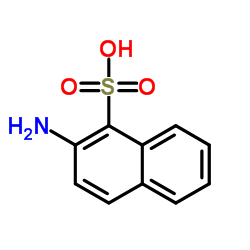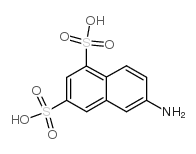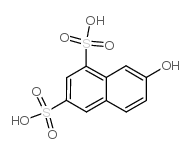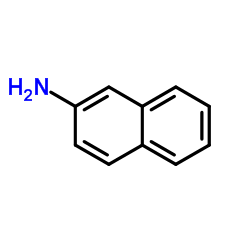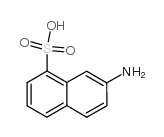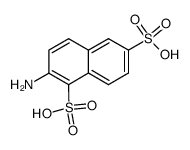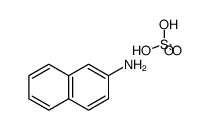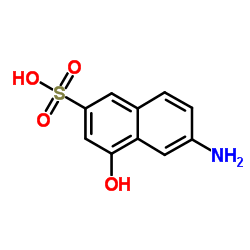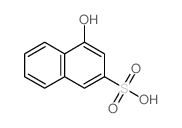86-65-7
| 中文名 | 7-氨基-1,3-萘二磺酸 |
|---|---|
| 英文名 | 7-Amino-1,3-naphthalenedisulfonic acid, tech. |
| 中文别名 |
氨基G盐
K酸 1-氨基-8-萘酚-4,6-双磺酸 7-氨基-1,3-萘磺酸 |
| 英文别名 |
EINECS 201-689-2
7-Amino-1,3-naphthalenedisulfonic acid MFCD00035721 |
| 密度 | 1.769 g/cm3 |
|---|---|
| 沸点 | 569ºC |
| 熔点 | 300°C |
| 分子式 | C10H9NO6S2 |
| 分子量 | 303.31200 |
| 精确质量 | 302.98700 |
| PSA | 151.52000 |
| LogP | 3.65820 |
| 储存条件 | 密封贮藏,储存在阴凉、干燥、通风良好的地方。 |
| 稳定性 | 与氧化剂反应。 |
| 水溶解性 | soluble |
| 计算化学 | 1.疏水参数计算参考值(XlogP):0 2.氢键供体数量:3 3.氢键受体数量:7 4.可旋转化学键数量:2 5.互变异构体数量:无 6.拓扑分子极性表面积152 7.重原子数量:19 8.表面电荷:0 9.复杂度:531 10.同位素原子数量:0 11.确定原子立构中心数量:0 12.不确定原子立构中心数量:0 13.确定化学键立构中心数量:0 14.不确定化学键立构中心数量:0 15.共价键单元数量:1 |
| 更多 | 1. 性状:浅棕色针状结晶 2. 密度(g/mL,25℃):未确定 3. 相对蒸汽密度(g/mL,空气=1):未确定 4. 熔点(ºC):300 5. 沸点(ºC,常压):569 6. 沸点(ºC,50mmHg):未确定 7. 折射率(n20/D):未确定 8. 闪点(ºC):未确定 9. 比旋光度(º):未确定 10. 自燃点或引燃温度(ºC):未确定 11. 蒸气压(mmHg,40ºC):未确定 12. 饱和蒸气压(kPa,125ºC):11.32 13. 燃烧热(KJ/mol):未确定 14. 临界温度(ºC):未确定 15. 临界压力(KPa):未确定 16. 油水(辛醇/水)分配系数的对数值:未确定 17. 爆炸上限(%,V/V):未确定 18. 爆炸下限(%,V/V):未确定 19. 溶解性:与水溶解 |
Synonym:Amido G Acid; 7-Naphthylamine-1,3-Disulfonic Acid Section 2 - COMPOSITION, INFORMATION ON INGREDIENTS
Risk Phrases: 34 Section 3 - HAZARDS IDENTIFICATION EMERGENCY OVERVIEW
Causes burns.Corrosive. Potential Health Effects Eye: Causes eye burns. May cause chemical conjunctivitis and corneal damage. Skin: Causes skin burns. May cause skin rash (in milder cases), and cold and clammy skin with cyanosis or pale color. Ingestion: May cause severe and permanent damage to the digestive tract. Causes gastrointestinal tract burns. May cause perforation of the digestive tract. The toxicological properties of this substance have not been fully investigated. May cause systemic effects. Inhalation: May cause severe irritation of the respiratory tract with sore throat, coughing, shortness of breath and delayed lung edema. Causes chemical burns to the respiratory tract. The toxicological properties of this substance have not been fully investigated. Aspiration may lead to pulmonary edema. May cause systemic effects. Chronic: Effects may be delayed. Section 4 - FIRST AID MEASURES Eyes: Get medical aid. Do NOT allow victim to rub eyes or keep eyes closed. Extensive irrigation with water is required (at least 30 minutes). Skin: Get medical aid. Immediately flush skin with plenty of water for at least 15 minutes while removing contaminated clothing and shoes. Wash clothing before reuse. Destroy contaminated shoes. Ingestion: Do not induce vomiting. If victim is conscious and alert, give 2-4 cupfuls of milk or water. Never give anything by mouth to an unconscious person. Get medical aid. Inhalation: Remove from exposure and move to fresh air immediately. If not breathing, give artificial respiration. If breathing is difficult, give oxygen. Get medical aid. Do NOT use mouth-to-mouth resuscitation. If breathing has ceased apply artificial respiration using oxygen and a suitable mechanical device such as a bag and a mask. Notes to Physician: Section 5 - FIRE FIGHTING MEASURES General Information: As in any fire, wear a self-contained breathing apparatus in pressure-demand, MSHA/NIOSH (approved or equivalent), and full protective gear. During a fire, irritating and highly toxic gases may be generated by thermal decomposition or combustion. Extinguishing Media: Use agent most appropriate to extinguish fire. Use water spray, dry chemical, carbon dioxide, or appropriate foam. Section 6 - ACCIDENTAL RELEASE MEASURES General Information: Use proper personal protective equipment as indicated in Section 8. Spills/Leaks: Clean up spills immediately, observing precautions in the Protective Equipment section. Sweep up, then place into a suitable container for disposal. Avoid generating dusty conditions. Provide ventilation. Section 7 - HANDLING and STORAGE Handling: Wash thoroughly after handling. Use with adequate ventilation. Minimize dust generation and accumulation. Do not breathe dust, vapor, mist, or gas. Do not get in eyes, on skin, or on clothing. Keep container tightly closed. Avoid ingestion and inhalation. Discard contaminated shoes. Storage: Store in a tightly closed container. Store in a cool, dry, well-ventilated area away from incompatible substances. Corrosives area. Section 8 - EXPOSURE CONTROLS, PERSONAL PROTECTION Engineering Controls: Facilities storing or utilizing this material should be equipped with an eyewash facility and a safety shower. Use adequate ventilation to keep airborne concentrations low. Exposure Limits CAS# 86-65-7: Personal Protective Equipment Eyes: Wear appropriate protective eyeglasses or chemical safety goggles as described by OSHA's eye and face protection regulations in 29 CFR 1910.133 or European Standard EN166. Skin: Wear appropriate protective gloves to prevent skin exposure. Clothing: Wear appropriate protective clothing to prevent skin exposure. Respirators: A respiratory protection program that meets OSHA's 29 CFR 1910.134 and ANSI Z88.2 requirements or European Standard EN 149 must be followed whenever workplace conditions warrant respirator use. Section 9 - PHYSICAL AND CHEMICAL PROPERTIES Physical State: Needles Color: light brown Odor: None reported. pH: Not available. Vapor Pressure: Not available. Viscosity: Not available. Boiling Point: Not available. Freezing/Melting Point: > 300 deg C Autoignition Temperature: Not applicable. Flash Point: Not applicable. Explosion Limits, lower: Not available. Explosion Limits, upper: Not available. Decomposition Temperature: Solubility in water: soluble Specific Gravity/Density: Molecular Formula: C10H9NO6S2 Molecular Weight: 303.29 Section 10 - STABILITY AND REACTIVITY Chemical Stability: Stable under normal temperatures and pressures. Conditions to Avoid: Incompatible materials, dust generation, excess heat. Incompatibilities with Other Materials: Oxidizing agents. Hazardous Decomposition Products: Nitrogen oxides, carbon monoxide, oxides of sulfur, irritating and toxic fumes and gases, carbon dioxide, nitrogen. Hazardous Polymerization: Has not been reported. Section 11 - TOXICOLOGICAL INFORMATION RTECS#: CAS# 86-65-7: QJ6132000 LD50/LC50: Not available. Carcinogenicity: 7-Amino-1,3-Naphthalenedisulfonic Acid - Not listed by ACGIH, IARC, or NTP. Other: See actual entry in RTECS for complete information. Section 12 - ECOLOGICAL INFORMATION Section 13 - DISPOSAL CONSIDERATIONS Dispose of in a manner consistent with federal, state, and local regulations. Section 14 - TRANSPORT INFORMATION IATA Shipping Name: CORROSIVE SOLID, N.O.S.* Hazard Class: 8 UN Number: 1759 Packing Group: III IMO Shipping Name: CORROSIVE SOLID, N.O.S. Hazard Class: 8 UN Number: 1759 Packing Group: III RID/ADR Shipping Name: CORROSIVE SOLID, N.O.S. Hazard Class: 8 UN Number: 1759 Packing group: III Section 15 - REGULATORY INFORMATION European/International Regulations European Labeling in Accordance with EC Directives Hazard Symbols: C Risk Phrases: R 34 Causes burns. Safety Phrases: S 26 In case of contact with eyes, rinse immediately with plenty of water and seek medical advice. S 28A After contact with skin, wash immediately with plenty of water. S 37 Wear suitable gloves. S 45 In case of accident or if you feel unwell, seek medical advice immediately (show the label where possible). WGK (Water Danger/Protection) CAS# 86-65-7: 1 Canada CAS# 86-65-7 is listed on Canada's NDSL List. CAS# 86-65-7 is not listed on Canada's Ingredient Disclosure List. US FEDERAL TSCA CAS# 86-65-7 is listed on the TSCA inventory. SECTION 16 - ADDITIONAL INFORMATION N/A |
|
毒理学数据: 1、慢性毒性/致癌性 小鼠经腹腔TDLo:7500mg/kg/8W-I; CHEMICAL IDENTIFICATION
HEALTH HAZARD DATAACUTE TOXICITY DATA
|
| 危害码 (欧洲) | C: Corrosive; |
|---|---|
| 风险声明 (欧洲) | R34 |
| 安全声明 (欧洲) | S26-S28A |
| 危险品运输编码 | 1759 |
| 包装等级 | III |
| 危险类别 | 8 |
| 海关编码 | 2921499090 |
|
~10% 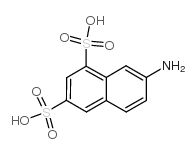
86-65-7 |
| 文献:US3979445 A1, ; |
|
~% 
86-65-7 |
| 文献:Journal fuer Praktische Chemie (Leipzig), , vol. <2>70, p. 347 Journal fuer Praktische Chemie (Leipzig), , vol. <2>69, p. 80 |
|
~% 
86-65-7 |
|
文献:Helvetica Chimica Acta, , vol. 6, p. 1147,1149 Grundlegende Operationen der Farbenchemie, 5. Aufl. |
|
~% 
86-65-7 |
| 文献:Chem. News J. Ind. Sci., , vol. 62, p. 163 |
|
~% 
86-65-7 |
| 文献:Chemische Berichte, , vol. 21, p. 3497 Oef.Sv., , p. 642 Chem. News J. Ind. Sci., , vol. 62, p. 163 |
|
~% 
86-65-7 |
| 文献:DE35019 ; Fortschr. Teerfarbenfabr. Verw. Industriezweige, vol. 1, p. 382 Chemische Berichte, 19 Ref. <1886>,277 Chem. News J. Ind. Sci., 24 Ref. <1891>,707,708 , vol. 61, p. 928 |
|
~% 
86-65-7 |
| 文献:DE27378 ; Fortschr. Teerfarbenfabr. Verw. Industriezweige, vol. 1, p. 416 |
|
~% 
86-65-7 |
| 文献:Chemische Berichte, , vol. 21, p. 3497 Oef.Sv., , p. 642 Chem. News J. Ind. Sci., , vol. 62, p. 163 |
| 上游产品 8 | |
|---|---|
| 下游产品 6 | |
| 海关编码 | 2921499090 |
|---|---|
| 中文概述 | 2921499090 其他芳香单胺及衍生物及它们的盐. 增值税率:17.0% 退税率:9.0% 监管条件:无 最惠国关税:6.5% 普通关税:30.0% |
| 申报要素 | 品名, 成分含量, 用途 |
| Summary | 2921499090 other aromatic monoamines and their derivatives; salts thereof VAT:17.0% Tax rebate rate:9.0% Supervision conditions:none MFN tariff:6.5% General tariff:30.0% |


